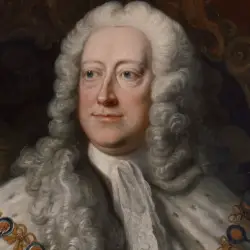
King George II Family Tree showing:
parents 
siblings 
partner 
children 
Short Biography
Early Years
King George II was born on 30th October 1683 to George of Hanover and Sophia Dorothea at Schloss Herrenhausen, Hanover. He was the couple’s first child, his sister Sophia was born in 1685.
George’s parents were not close and both had extra-marital affairs. They divorced in 1694 and George’s mother was banished to the Castle of Ahlden and forbidden to remarry. It is believed that George never saw his mother again.
George began his education at the age of four years. He was schooled in German, English, Italian, genealogy and military history.
Marriage and Family
In 1705, negotiations began for George to marry Caroline of Ansbach. Thje couple married on 22nd August 1705 at Herrenhausen, Hanover, Germany. Their first child, Frederick Louis was born on 1st February 1707.
The couple had a further seven children:
Anne – born 2nd November 1709, she married William IV, Prince of Orange
Amelia born 10th June 1711, she did not marry
Caroline – born 10th June 1713, she did not marry
George William – born 13th November 1717, died aged 3 months
William Duke of Cumberland – born 26th April 1721, did not marry
Mary – born 5th March 1723, married Frederick II, Landgrave of Hesse-Kassel
Louisa – born 18th December 1724, married Frederick V, King of Denmark and Norway
George’s wife, Caroline of Ansbach, died on 20th November 1737. George was deeply saddened by her death.
George’s son and heir, Frederick Louis, died on 31st March 1751. His son, George, became heir to the throne.
Path to the British throne
In 1698 George’s father became Elector of Hanover. Two years later, George’s grandmother, Sophia became second in line to the British throne after Princess Anne’s son, William Duke of Gloucester died. In 1702 King William III died and his sister-in-law Anne took the British throne as Queen Anne. George’s grandmother became heir to the throne.
By 1705 it was thought unlikely that Queen Anne would produce an heir to the throne. In preparation for their accession to the British throne, George and his family were created British subjects.
On 28th May 1714, George’s grandmother died and George’s father, George of Hanover, became heir to the British throne. Three months later, George of Hanover became King George I of Britain after Queen Anne died without issue. George became heir to the throne and gained the titles Duke of Cornwall and Rothesay.
George’s father died on 11th June 1727 and George became King George II of Britain. He was crowned on 11th October 1727 at Westminster Abbey. ‘Zadok the Priest’ composed by Handel, was played at the Coronation and has been used for all coronations since.
George and his father sailed for England on 18th September. His wife and daughters joined him a month later. His eldest son, Frederick was left in Hanover to represent the family and hold their German interests.
Jacobite Rebellions
The Hanoverians had acceded to the throne because they were the nearest Protestant relatives to Queen Anne. However, many believed that the throne should pass to Anne’s Catholic half brother, James Francis Stuart, son of King James II and Mary of Modena. They called themselves Jacobites.
The first rebellion took place in September 1715 when John Erskine, Earl of Mar raised the standard of James III of England VIII of Scotland. The Duke of Argyll was given charge of royalist forces. Unable to make significant gains, the rebellion failed.
In 1719, the Jacobites rose again but were quickly defeated at the Battle of Glenshiel.
In July 1745, Charles Edward Stuart, son of James Francis, known as Bonnie Prince Charlie, landed in Scotland determined to gain support and depose George II.
The Jacobites rose again and defeated the Royalist army at the battle of Prestopans in September 1745. However, six months later the Royalists led by William Duke of Cumberland scored a decisive victory at the Battle of Culloden, 16th April 1746.
Charles Edward Stuart fled the battlefield and left for France.
South Sea Bubble
The South Sea Company was founded to deal with the debt caused by George’s war with France. The new company took on three-fifths of the British National debt. The company then sought to generate income by trading in slaves.
Shares in the company rose at a phenomenal rate rising to over £1000. Many people decided to quit while ahead and sold their shares. This caused the price of the shares to fall drastically, within 3 months they had fallen to £150. Huge numbers of people lost money and laid the blame with the King and government.
Other notable events during the life and reign of King George II
Robert Walpole became first Prime Minister of Britain – 1721
War of Jenkin’s Ear – 1739
War of Austrian Succession 1740 – 1748
Battle of Dettingen – 27th June 1743 – George personally led British troops on the battlefield – the last monarch to do so
Seven Years War – 1756 – 1763
King George II died on 25th October 1760 following an aortic aneurysm. He was succeeded by his grandson, George, who became King George III.
Published Dec 14 , 2021 @ 11:07 pm – Updated – [last-modified]
Harvard Reference for King George II Family Tree:
Heather Y Wheeler. (2021 – ). King George II Family Tree (1683-1760). Available: https://www.treesofblue.com/king-george-ii-family-tree-1683-1760 Last accessed April 19th, 2025
